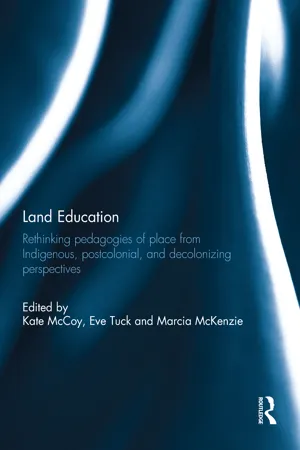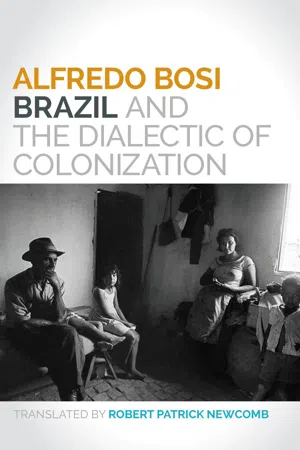History
Colonization of Brazil
The colonization of Brazil refers to the period when the Portuguese established control over the territory, beginning in the early 16th century. This colonization involved the exploitation of natural resources, the introduction of Portuguese culture and language, and the establishment of a plantation economy based on the labor of indigenous peoples and later enslaved Africans.
Written by Perlego with AI-assistance
Related key terms
6 Key excerpts on "Colonization of Brazil"
- eBook - ePub
Land Education
Rethinking Pedagogies of Place from Indigenous, Postcolonial, and Decolonizing Perspectives
- Kate McCoy, Eve Tuck, Marcia McKenzie(Authors)
- 2017(Publication Date)
- Routledge(Publisher)
The view that Nature is bountiful and replenishes itself has nourished the destruction of many ecosystems across several cycles of Brazilian economic history, including the export of products such as wood, gold, coffee, sugar-cane, latex rubber, livestock and, more recently, soybeans. These economic cycles are only possible because, and at the expense, of the local ecosystems. Yet, as ecosystems become depleted, the frontiers of exploration and exploitation have advanced toward those remaining and intact ecosystems. The states of Brazil, therefore, have become scarred with the violence meted out on the preceding habitats and their inhabitants.Driven by this hegemonic conception of land and economic development, under the aegis of the capitalist mode of production, the production–consumption system of the modern Brazilian state still follows the modus operandi practiced in colonial Brazil. Oligarchies remain entrenched, assuring the perpetuation and near permanence of large land property owners controlling economic affairs. As with Porto-Gonçalves (2004), we can characterize this situation as that of a modern-colonial world, as distinct from a post-colonial form. The ‘modern-colonial’ was introduced by historians to signify the persistence of the rhetorical power of European universalism (Mignolo 2003, 2008), while according to Ashcroft, Griffiths & Tiffin (2001, 186), ‘from the late 1970s the term has been used by literary critics to discuss the various cultural effects of colonization,’ as distinct to closely related terms associated with the political and economic transitions primarily marked by some post-colonial theories (see the work of Fanon (1979), Bhabha (1994), Wolfe (1999, 2006), Anderson (2008) and Veracine (2011).Applying the insights of modern colonialism and post-colonialism noted above to this situation, we can summarize that colonization as a set of practices still stands and has been stamped on Brazil, from the first wave of colonization by the Portuguese since the 1500s, and throughout the slower transition to a process of settler colonialism by Europeans mainly from Portugal and Spain in subsequent centuries. Many Indigenous people were enslaved by the colonists as chattels during the seventeenth and eighteenth centuries to service the agricultural economy, and those who resisted were often decimated in the name of Portuguese Crown. Throughout the eighteenth and nineteenth centuries, the Portuguese also introduced the bulk of African slaves to support the sugar economy, as well as cattle ranching and other foodstuff production, including coffee. While by 1888, Brazil was one of the last countries in the Western world to abolish slavery of both Africans and Iindigenous peoples. - eBook - ePub
- Riordan Roett(Author)
- 2011(Publication Date)
- Brookings Institution Press(Publisher)
The interaction of these five historical realities shaped the Portuguese experience in the New World. First, strong, assertive families and clans that were a world unto themselves came to control large tracts of land in Brazil's northeast, providing a paradigm for later settlement. Second, the weakness and relative passivity of the colonial government strengthened the local clans' right to rule. Third, the creation of a workforce based on imported African slaves, not native labor, set the tone for Brazil's social and economic development for the next two-and-a-half centuries. Fourth, dependence on natural resources became and remained the country's economic model well into the twentieth century. And finally, the expansion of the colony's borders consolidated Brazil's potential as a great power.The development of an independent Brazilian identity was supported by the continued decline of Portugal. The King of Spain occupied the Portuguese throne between 1580 and 1640. Increasingly, the relationship between Portugal and its largest colony was driven by Brazil's ability to provide a steady stream of income for a decadent former power largely isolated on the edge of Europe. Reform efforts were undertaken from time to time in Lisbon to better integrate Brazil into the surviving Portuguese mercantilist system, but with limited results.As the colonial period wound down, Brazil was not a sophisticated colony when compared to imperial centers like Mexico City or Lima. Unlike Spain, Portugal had not promoted universities or allowed printing presses, fearing the creation of an enlightened or at least a literate elite, and the controversial decision in the 1750s to expel the Jesuits severely damaged what little educational infrastructure the colony had. Rural plantation owners dominated the social order, supported by a large slave population, followed by a mixed bag of merchants, bureaucrats, clergy, and artisans. The social scene was further complicated as time went on by a large pool of freed slaves in the urban centers. While inroads had been made in exploring the interior of the country, Brazil remained a basically coastal society with only fragments of understanding regarding the inland portions of the country.By the end of the 1700s, Brazilians had increasingly begun to disassociate themselves from Portugal. This trend was accelerated by two developments that set the scene for Brazilian independence in 1822. The first was the wave of revolutions that shook the traditional European powers—the American War of Independence in 1776 and the French Revolution in 1789. These events inspired the emergence of new ideas and new local leaders in Brazil and ultimately a series of dramatic but failed efforts to declare independence from Portugal. The second crucial development was Napoleon Bonaparte's decision to invade the Iberian Peninsula in late 1807. Urged on by Great Britain, which had been Portugal's major trading partner since the seventeenth century, the regent, Prince João, decided to move the entire court to Brazil. In November 1807, under British naval protection, the government abandoned Lisbon for the New World. In contrast, the Spanish royal family was taken hostage by Napoleon. - eBook - ePub
- Johannes Kabatek, Albert Wall, Johannes Kabatek, Albert Wall(Authors)
- 2022(Publication Date)
- De Gruyter(Publisher)
versus the enslaved, since there was a significant portion of the population consisting of poor white peasants (Fausto 1995, 58–59).At the beginning of colonization, the movement of migrants from Europe was characterized as spontaneous yet selective: adult men of different social strata predominated, coming mostly from the Northwest of Portugal and the Atlantic islands, as well as a considerable number of new Christians (Jews required to “convert” to Christianity). The almost exclusive presence of men, from the beginning, fostered intense racial mixing, which was fundamental to the creation of the Brazilian population. It is also relevant from the perspective of a linguistic history, since mixed-race peoples are a link between linguistically-distinct worlds.The 1530s saw another predominantly male migratory movement, which was also selective but not spontaneous: the arrival of enslaved Black Africans. Brazil was the last country to abolish slavery in the West, only in 1888. Slave trade remained legal until 1850, and although it is not possible to precisely determine how many were brought to Brazil, it is estimated that between 8,000,000 and 11,000,000 enslaved Africans were brought to the Americas, and approximately 4,900,000 of this total were brought to Brazil (Schwarcz/Starling 2015, 82). In the 16th century, Portuguese smugglers used the term “Guinea negro” to describe Africans. In an inquiry into what Guinea was in the early days of slave trade, Oliveira (1997) reported that all of West Africa north of the Equator, from the Senegal River to Gabon, was then known as Guinea, and stated that the term also came to be applied to populations south of the Equator. It can be concluded, therefore, that since the beginning, languages were transplanted from two sub-Saharan regions, and would characterize the entire history of slave trade in Brazil: those of West Africa, including languages ranging from Senegal to Nigeria, and Bantu, with languages spanning the entire continent south of the Equator. The languages of the African continent are classified into four groups: Congo-Kordofanian, Nilo-Saharan, Afroasiatic, and Khoisan; Congo-Kordofanian is subdivided, in turn, into two families: Niger-Congo and Kordofanian.2 - eBook - ePub
The Dynamics of Language and Inequality in Education
Social and Symbolic Boundaries in the Global South
- Joel Austin Windle, Dánie de Jesus, Lesley Bartlett(Authors)
- 2020(Publication Date)
- Multilingual Matters(Publisher)
Brazil was applied to a portion of those colonial possessions that did not include the Amazon. In addition, the colonization of the Amazon under Portuguese rule began than the rest of ‘Portuguese’ America, almost a century later.In the period and space discussed in this chapter, translation and teaching are terms intrinsically linked to one another. The main objective of the missionaries, especially the Jesuits (considered in the history of Brazil as the country’s first educators and teachers), was the evangelization of indigenous populations. This could only be done by means of a linguistic policy that would hasten integration of indigenous people into religious missions, by, instead of teaching the language of the colonizer, focusing on constructing a lingua franca, based on Tupi, in which conversion to Catholicism could be performed. The schools created by the Jesuits were based on the knowledge of this lingua franca, into which the rudiments of the Catholic faith were translated. From a certain phase, around the second half of the 18th century, a dispute began between those who undertook conversion and teaching through the língua geral and those who supported the implantation of the Portuguese language:During this tumultuous phase, questionnaires were sent to all sections of the local hierarchies in order to collect the necessary data for the adoption of new solutions. They deal with matters related to the sharing of missions and their territory amongst the various [teaching] institutions, their competence, and the curriculum for indigenous peoples (including the Portuguese language or more advanced studies, with the Order of Mercedarians even proposing Latin). The pedagogical, political and ecclesiastical arguments typical of each segment were reflected in their answers. Likewise, in addition to the different perspectives on the configuration of civil and ecclesiastical powers, different positions emerged concerning the capacities of the indigenous peoples, the learning of the catechism, and an elementary, technical or even more advanced pedagogy. In all domains, language appeared as an important dimension of power - eBook - ePub
Colonial Fantasies, Imperial Realities
Race Science and the Making of Polishness on the Fringes of the German Empire, 1840–1920
- Lenny A. Ureña Valerio(Author)
- 2019(Publication Date)
- Ohio University Press(Publisher)
10 Colonization in Brazil, as in the rest of Latin America, was thus an immigration project with a specific biopolitical agenda for the country.The Land Law also affected newly arrived immigrants, given that land value was too high for them. It was used as a mechanism to keep immigrants working long enough on plantations to fulfill contracts, a major concern of coffee plantation owners, and as a way to support the colonization program by investing the profit of land sales in projects that stimulated European migration.11 The legal regulation of the sale of land and a series of additional decrees adopted in Brazil to protect property rights ended up promoting the arrival of new German colonists. Up to the 1870s, the majority of colonies established in the southern Brazilian provinces were German. Polish colonists generally benefited from the colonization networks that Germans established in Latin America, and the first Polish settlers to come to Brazil were Prussian Poles.As early as 1865, at the request of Zacarias de Góis e Vasconcelos (Bahia’s senator in the General Assembly) and others, the Brazilian government approved a decree allowing the creation of a society for the promotion of Polish colonization. The organization, called the Beneficent Society for the Promotion of Polish Colonization (Sociedade Beneficente Promotora da Colonização Polaca), had its headquarters in Rio de Janeiro but could operate to establish colonies in any province of the empire.12 It explicitly recruited Catholics. The society could place Poles on agricultural plots acquired through legal means, on private land through partnership or salary contracts (contractos de parceira ou de salario ), in workshops or manufactories, and in domestic service. I have not been able to find much about the works of this society, but it seems to be connected with the activities of a Polish count named Antônio Ladislau Jacienski, who in 1864 formed the Association for the Promotion of Polish Colonization in Brazil (Associação Promotora da Colonização Polaca do Brasil) in the northeastern region of Pernambuco.13 The provincial government used lottery funds to support this colonization project, which attracted 2,700 immigrants, failing to yield the results that Brazilians expected in Pernambuco.14 - eBook - ePub
- Alfredo Bosi, Robert Patrick Newcomb(Authors)
- 2015(Publication Date)
- University of Illinois Press(Publisher)
They illustrate the uses and abuses to which the Portuguese subjected Amerindians and Africans, both at the level of the global economy and in daily material and corporeal practice. Why should we idealize what occurred? Should Brazilian scholars compete with other colonized peoples to decide who was best colonized? I do not believe that this careless and often naïve game of comparisons, stacked to favor our colonizer, can lead to an adequate understanding of the process. We must ask if, along with the most evident of the adaptations alluded to above, the forces of cult and culture (and the art that feeds on both), succeeded, through their capacity to grant meaning to life, in addressing that which routine left unfulfilled or untouched. The reproduction of a certain set of habits certainly helped to prop up the colonial structure, but was the consuming, producing, and trading machine of colonization able to respond to the full range of values, ideals, dreams, and desires that issued from the past or that were projected, at least in potential form, into the future of both the colonizer and the colonized? In other words: was colonization a process defined by moments of fusion and construction, which ultimately balanced out material wants and symbolic forms, immediate needs, and imaginary worlds, or did colonization also produce, in addition to a machinery of interlocking parts, a dialectic of ruptures, differences, and contrasts? Marx's words on the role of religion in oppressed societies help explain the tendencies of certain social groups toward the imaginary expression of their desires: religion is the “heart of a heartless world and the soul of soulless conditions.” 23 A society's symbolic labor can reveal the dark consequences of forced labor and the search for new, freer forms of existence
Learn about this page
Index pages curate the most relevant extracts from our library of academic textbooks. They’ve been created using an in-house natural language model (NLM), each adding context and meaning to key research topics.





